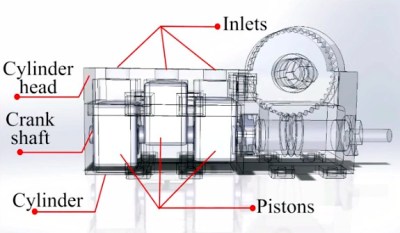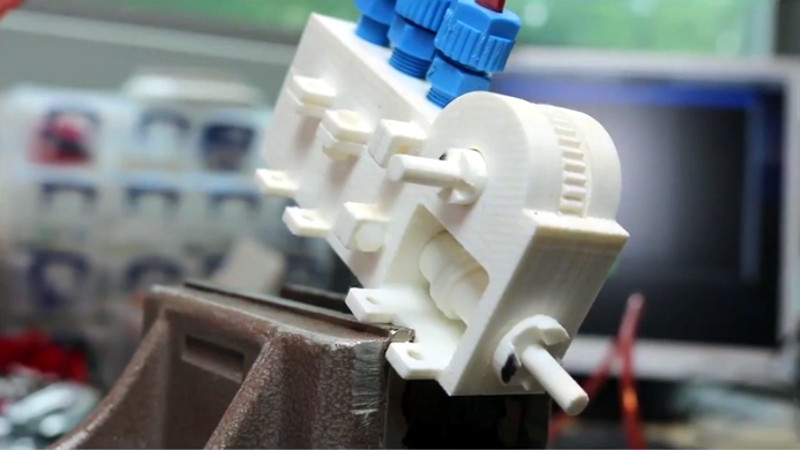You will no doubt have seen those videos where MRI machines suck up all sorts of metallic objects with hilariously disastrous results. The magnetic field in one of these machines can easily pull in metal objects from across the room, exerting a force of several hundred pounds on any ferrous object unlucky enough to wander too close. As you can probably imagine, designing mechanical devices that can operate in such an intense magnetic field is exceptionally difficult.
 But this fully 3D printed pneumatic stepper motor designed by [Foad Sojoodi Farimani] might one day change that. The PneuAct, which he presented at the recent International Conference on Robotics and Automation (ICRA) in Brisbane, Australia, manages to run at up to 850 RPM with full position control using bursts of air rather than electronic pulses. Made entirely of plastic and without any electronic components, the PneuAct can not only operate in intense magnetic fields but also areas with flammable gases where sparks could potentially cause an explosion.
But this fully 3D printed pneumatic stepper motor designed by [Foad Sojoodi Farimani] might one day change that. The PneuAct, which he presented at the recent International Conference on Robotics and Automation (ICRA) in Brisbane, Australia, manages to run at up to 850 RPM with full position control using bursts of air rather than electronic pulses. Made entirely of plastic and without any electronic components, the PneuAct can not only operate in intense magnetic fields but also areas with flammable gases where sparks could potentially cause an explosion.
We often say that a design is “fully” 3D printable, even though it might require screws or other bits of hardware. But in the case of the PneuAct, it’s truly all printed. It has to be, or else the whole thing would be ripped apart when it got to close to the MRI machine. Each and every piece of the motor is printed in ABS, and can be used without any additional machining or cleanup. No lubrication is required, and [Foad] mentions that the whole thing is so cheap that it can be disposable. Which is a huge advantage in medical environments where contamination could be a concern.
Design-wise the PneuAct is essentially an expanded version of the 3D printed air motors we’ve seen previously, but it would be fair to say that none has ever been studied so closely before.
















>it’s truly all printed. It has to be, or else the whole thing would be ripped apart when it got to close to the MRI machine
Non-ferrous metals do, in fact, exist…
Non-ferrous metals are also a hazard near an MRI, due to the large pulsed fields. The changing field induces a current in any conductor, which produces a field opposing the change, and you get a repulsive force, as well as resistive heating. For an example https://www.wired.com/2014/01/physics-of-the-electromagnetic-ring-launcher/. This is also the basis for a magnetic brake, such as on a triple beam balance (not a magnetically actuated brake, like for a trailer)
That’s a real but overblown fact. Your braces or surgical pins aren’t going to roast your bones or shoot through your body if you lay in an MRI. Small screws are only going to distort the image or make processing the signal harder. MRI operates in single or tens of MHz so most things make poor antennae.
Titanium, I have 5 Titanium screws in my ankle, got few times MRI with it, did anything go wrong? NO.
Which doesn’t say much as your titanium being mounted in a place and in a material designed to withstand mechanical stress.
I’ve had ligature wires in my face for 30 years, and have had 10 brain MRI studies with them present. Never felt a thing, and they didn’t cause a problem for the machine in any way. Also, during most MRIs I’ve had, they didn’t even ask me to remove my wedding ring. Again, I’ve felt nothing. No heating, no tugging, nothing of the sort. My tattoos haven’t caused any problems either.
I guess House MD lied to us all. (for those unfamiliar: House MD is a medical TV show that often portrayed MRI machines as capable of ripping titanium pins from bones and cooking tattooed flesh.)
Ah, the joys of medical TV shows!
Doctors often get a bunch of patients, shortly after a program airs, experiencing the symptoms of a mythical disease in the program’s plot!
Yeah, not really. Especially not just outside the bore.
I have done some testing of medical leadwires and electrodes in an MRI at our local hospital. My initial testing was done to uncover any safety issue. The second series was done to determine what effect electrodes would have on the image quality (artifacts, etc). Ag/AgCl electrode are radio-translucent, which is a plus. We also tested carbon-based leadwires, but it has significant resistance. We also developed some plating techniques, because standard gold plating has a layer of nickel under it, and nickel does not play well with intense magnetic fields.
additionally, mcmaster will gleefully sell you nuts and bolts in a few kinds of plastic and ceramic. material properties, and the use of a tap&die set are all that stand between a person and putting threads into whatever other material they like.
plus there’s glue.
Those blue fiberglass polypropylene compression tube fittings don’t look particularly 3D printed.
“unlucky” – how do you know iron doesn’t _like_ flying? If you’re between it and the object of its desire, you’re the unlucky one.
I suspect conductivity is also important in the presence of the RF they use for this, else you’d just use some non-magnetic, say, Ti or Al screws if you wanted screws.
Metals interfere with the imaging. You can have surgical screws or other metal implants in an MRI is just a bit more difficult to get a clear picture. If the operators aren’t paying attention (or don’t know) there’s a slight risk of burns to the patient, but it’s pretty easy to avoid.
I would take issue with the sparking. A real stepper has no brushes so there is no electrical sparking. Most steppers are made out of metal so they can be grounded so they should not develop static charges. I am not so sure about something that is all plastic. Still, a 3D printable pneumatic stepper is a neat idea. Just out of curiosity, what do you develop the air pulses with?
I guess you could use solenoids etc, but those can be far away, outside of the MRI danger zone.
I tend to agree… I would guess any concern of sparking would be due to the ferrous components (and other hard metals) in conventional motors, or risks due to electrical faults, but, again, only a guess.
I would, personally, be concerned using raw ABS, or other untreated polymer in a flammable atmosphere. The motion of the working fluid is likely to lead to static charge buildup which will cause sparking. Surface treatment would alleviate this.
As for HOW the sequenced pulsed air can be produced, turn another unit with a conventional motor outside the danger zone, or use solenoid valves as mentioned, or use a distributor (similar to the fuel distributor in many conventional diesel engines) with a conventional compressor and reservoir, or….
The stepper itself shouldn’t spark, no. But wires frayed from repetitive motion which lead into it are another story entirely.
pneumatic logic? We did develop a huge number of interesting little blocks to play with with pneumatic logic, but it’s almost entirely been relegated to the wayside in favor of microprocessors outside of specialist applications.
Specialist, like auto transmissions.
Even automatic transmissions ditched mechanical logic in favor of electronically controlled hydraulic solenoids.
One step closer to a fully 3d printed 3d printer. ;)
Almost every player piano made had one of these to turn the roll. They usually have a metal crankshaft though, the rest is wood and rubberized cloth. It has very little inertia and starts and stops quickly. Run it on a regulated vacuum and it’s constant speed with variable load.
hey guys, I’m the developer of PneuAct. feel free to ask any questions here or via email.
Which email? Be more clear…
Sorry for the late reply. You may contact me via f.s.farimani@gmail.com or my Twitter @fsfarimani
Yeah, but can it be driven by a TMC2130?
pneumatic 555 anyone?
I worked at a hospital for 9 years.
The first time I had to go and change a light in the scanning room. I supposedly had a fiberglass ladder that was suppose to be safe for the area. The CT room did have there own ladder but it was not safe to use it was all broken up. So I had to order a new ladder. I had just got the new ladder in and was trying it out. I went into the room and the CT ripped the ladder out of my hands. I was lucky no damage to the CT. We looked at the ladder and found out they had used steel ribbits to hold everything together.
So I’m now going up the ladder and the CT is pulling my boots. That was so so weird. I am amazed at how strong the CT scanners are.
Changing the subject abit.
I was all so the man to call to cut the head of nails off as well. The doctors did not have the strength to cut them. And the 9 years I was there they never wanted to order the proper tool to do the job. Not in the budget.
And yea a great idea. If you can find a outfit to do all the testing and paper work, your all set.
Good luck
” they had used steel ribbits to hold everything together.”
metal frogs? Ribbit! Ribbit!
B^)
Back in the late 1970’s or early 1980’s a tech was injured by forks pulled off of a fork lift by an MRI that was being tested before shipping. The forks pinned him to the magnet. The magnet also pulled the scissors out of the hand of one of EMT’s that had resonded…
It was new technology, experiencing new problems.
CT does not attract stell. MRI does.
This is incredibly cool.
Pair of my colleagues pulled it off in 2011
http://aimlab.wpi.edu/research/projects/Pneumatic_Stepping_Motor